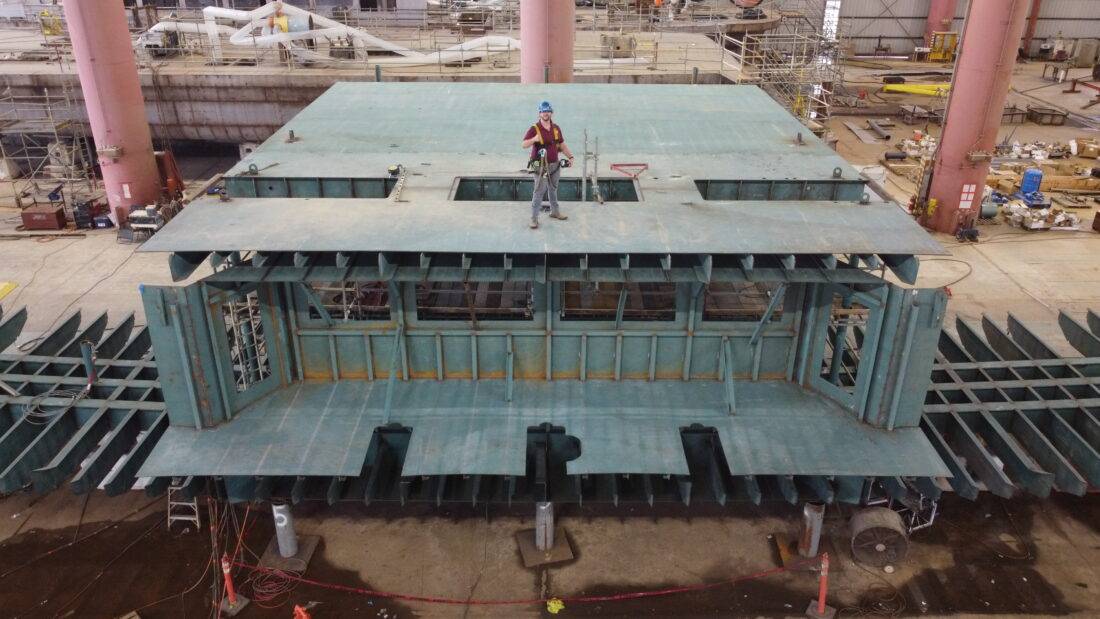Former Student Hybrid Design Recognized in 2024 “10 Significant Boats”

When Ryan Rendall ’12 started a new job as a naval architect and marine engineer with The Shearer Group in 2017, he was excited to join the team designing a new ferry for the Texas Department of Transportation (TXDoT). The marine engineering technology graduate was a key player in the project, responsible for its design and oversight of construction. On November 12, the ferry, which The Shearer Group delivered to TxDOT earlier this spring, was recently named one of WorkBoat Magazine’s 10 Significant Boats of 2024.
“I knew I needed to be a part of it,” Rendall said. “It’s a dream to be able to help the community through my work.”
As a leader of the project, Rendall played a key role from design to delivery of the vessel, and now is on call with TxDOT for troubleshooting and support whenever he and his team, including fellow marine engineering technology graduates Ethan Johnson ’14 and William Ryan Hentschel ’12, can be of service.

Esperanza “Hope” Andrade, named after the first Latina Texas Secretary of State and first female TxDOT chair, showcases a design that integrates cutting-edge technology with a commitment to sustainability. TxDOT operates the vessel at a speed of 12 knots, or just under 14 miles per hour, and while Rendall says there are similar vessels, none of them operate under the same federal regulations for passenger vessels.
The Shearer Group designed Esperanza “Hope” Andrade specifically for local operations at the Galveston-Bolivar ferry route. The ferry’s diesel-electric power generation system features two generators online during transit, with the batteries supplying the remainder of the power demands. As the ferry unloads and loads at the dock, the generators stay online and use excess power to recharge its lithium battery charges, readying to cross the channel for the next trip. Built exclusively of American-made steel, it’s the largest vessel in TxDOT’s fleet at a length of 293 feet.
“At the time, there were concerns about the safety of lithium batteries,” Rendall said, referencing when the ferry’s design work started. “We demonstrated that our system was safe, including rigorous testing and a fully redundant safety system. Each compartment is watertight and airtight to make sure if there’s thermal runaways they would be isolated and would not impact passengers or evacuation.”
Rendall explained that many of the manual systems on a more traditional ferry have been automated on the new vessel, and joked that the control panels are a little reminiscent of Star Trek. He noted that while the new technology is advanced, it’s designed to be intuitive for the crew and that his team was readily available for training and assistance.
Rendall knew early on that he wanted to be a naval architect, and ultimately decided to attend the Galveston Campus based on the affordability of the university’s program. However, he recalls how quickly he fell in love with the campus and how effortless being part of the community felt.

“I remember entering campus and feeling like I was home,” Rendall said. “Texas A&M-Galveston helped shape me into who I wanted to be.”
Rendall credits marine engineering technology professors Dr. Rudy Martinez and Gerard Coleman as being particularly influential in his career. A decade ago, while Rendall was working for another company, Coleman gave Rendall a business card for The Shearer Group, telling him to keep it in his metaphorical back pocket and “to call those guys some time,” Rendall recalls.
The Shearer Group, based in Houston, focuses primarily on inland marine vessels, including ferries and tugboats. Rendall is appreciative of the office/shipyard combination, which allows him to watch his designs come to life during construction.
“It’s an amazing feeling for my plans to be appreciated,” Rendall said about WorkBoat’s recognition of the ferry. “But moreso, it’s incredibly rewarding to see what I drew on paper turn into something that benefits the community.”
Media Contact
Taylor Bounds
bounds@tamu.edu
409-740-4929